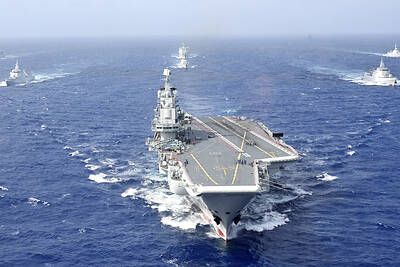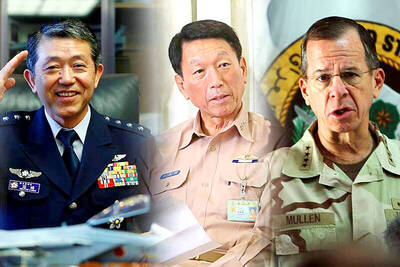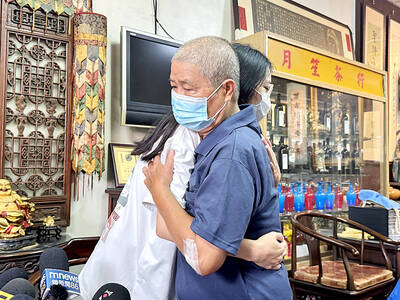For the Taiwanese, Matsu -- goddess of the sea and queen of heaven -- is a deity many know about but few have actually seen face-to-face.
The same could be said of the Matsu islands north of Taiwan that were originally named for the goddess. When you actually do see them for yourself, you find they are more beautiful than you could have imagined and almost completely unlike anything you have seen before. Today's Matsu is a mosaic of military history overlaid on a maritime culture, carved out of solid granite cliffs.
We were in Matsu for a tour that would include Dongyin, Beigan and Nangan.
Dongyin Lighthouse
The Dongyin Lighthouse sits on the northeast side of Dongyin, perched atop a rocky mountain at the end of a peninsula facing the Taiwan Strait. It is perhaps the most famous of all the lighthouses in Taiwan, and the one that appears on all the postcards of Matsu.
The best photos are taken on a sunny day against a background of blue sky and aquamarine ocean that perfectly offsets the stark white gown of this "Maiden of the Mist".
But it is only on a less-than-perfect day -- when the island lies half-shrouded in fog -- that you can understand why the British built this lighthouse to guide ships on their way to China. It also explains the cannons that lies about 50m down the cliff from the lighthouse. These cannons did not ward off Japanese pirates or Chinese invaders. They were fog cannon to warn ships about the treacherous rocks below the cliffs.
Thread of Sky
Across the bay from the Dongyin Lighthouse is a unique place where the waves have carved out a cleft in the rock. The cleft forms a narrow passageway, with steep granite walls that rise straight to the sky. As you look up from near the bottom of this crevice, you can see only a thin, blue ribbon of sky. This is why the soldiers who dug in here called this place Yihsiantian or "Thread of Sky."
Another feature of this place, which remains an important military outpost, is the sound of crashing waves echoing against the walls. They say that when you hear the echoing waves here, you can imagine the sound of a thousand horses galloping through the crevice.
Andong Tunnel
The mountains of Matsu are hollow. Every one of them has been excavated to provide fortifications and shelters for Taiwan's military. On Dongyin, the most famous of these excavations is the Andong Tunnel, which was once home to 1,000 troops.
The underground fortress consists of one main tunnel that branches out into five smaller tunnels, each ending at an opening in the sea cliffs that offers a commanding view of the strait. Once upon a time, these outlooks were used to keep an eye out for enemy ships or enemy frogmen trying to sneak up on the shore. Today, they offer five great vantage points for looking out across the blue-green waters of the bay.
The tunnel leading to the sleeping quarters for the troops offers a view of a different kind: a look at the lives of the men who called this place home. Painted on the walls of the tunnel -- in large red characters -- are slogans that were meant to inspire the men in their fight against the communist hordes. Roughly translated, the inscriptions encourage the soldiers to "Be Strong" "Be Quiet", "Persevere", "Be Brave"' and "Be Solemn".
Qingbi Village
The old village of Qingbi represents the most traditional village in Beigan. If you rise early and go to Qingbi, you can watch the sun rise over the ocean. Like most of Matsu's villages, it's situated by a coastal inlet with houses facing out to sea and backing onto the hillside. As the morning sun climbs over the horizon, the village is still and peaceful. The dawn's early light casts long shadows from the stone-walled buildings.
Qingbi by dawn is as pretty as a picture, but unnaturally quiet. Most of the former villagers have moved away and sometimes it feels like a ghost town.
According to local history, houses were well made because many pirates used to live in Qingbi, making it one of Matsu's wealthiest spots. There is rumor that a pirate's treasure is still buried under one of the buildings. However, the cellar has now been filled in and no one knows for sure if the story is true. It's one of the enduring mysteries of Qingbi.
Tangchi Village
The pristine waters off Matsu provide abundant fishing grounds, making them a paradise for sportsmen and the lifeblood of Matsu. Of the many fish products from Matsu, perhaps the best known are fish noodles and fish balls. And Tangchi has the reputation for having the best.
Fish noodles and fish balls here are made from high-grade fish and have a have a very high fish-to-flour ratio. The noodles go excellently in a hot pot, and are also delicious served as a regular bowl of noodles. The fish balls go great in a soup. Both carry a tasty fish flavor. The flour-heavy fish balls and noodles they make on Taiwan can't begin to compare.
Niuchiao Village
Niuchiao is a fishing village carved into the side of a slope that edges down to a natural harbor. This is where the restoration and preservation of Matsu villages began. And as such, Niuchiao provides one of the best examples of the eastern Fujianese architecture that was once common on all these islands: hewn-wood interiors, tile roofs, and exterior walls of dressed or rough-cut stones.
Many of these houses have remained occupied. Others have been painstakingly restored to their former splendor. As such, they really are a "living museum" offering a glimpse into the way people used to live.
Tunnel 88
Tunnel 88 is an old military tunnel that was re-named to mark the 88th birthday of former president Chiang Kai-shek(蔣中正). The tunnel, dug into the side of a hill, was once used to store tanks and shelter soldiers. These days though, the tunnel is more famous as the wine cellar for the nearby Matsu Winery.
These days, the winery is best known for its kaoliang. But it was once best known for its laojiou or "old wine" -- a traditional rice wine that was aged for at least 15 years. The problem with the old wine was that the winery didn't have proper facilities to store and age the vast quantities they were producing. But when the military abandoned Tunnel 88, the winery immediately saw the advantages of having a ready-made wine cellar with a natural climate control. They "borrowed" military excavation and -- in a stroke of marketing genius -- re-branded their generic product as "Tunnel 88."
Sales of the kaoliang took off. But the Tunnel 88 wine cellar is still filled with jars of ancient wine.
Beihai Tunnel
Another famous tunnel on Nangan is the Beihai (North Sea) Tunnel. Like similar tunnels here and in Kinmen, it is an underground quay meant for bringing in supplies and protecting navy vessels from enemy fire. And, like other tunnels, it was hacked out of the rock using simple hand tools.
Once, it was an essential lifeline for the soldiers stationed here. When in use, the tunnel could accommodate several naval vessels or dozens of smaller boats.
The corridor leading down from the surface passes large chambers hacked into the rock that once served as offices and sleeping quarters.
At the bottom of this shaft is a network of corridors, about 640m in all laid out in a stet shape. At low tide, the water in the channels is about 8 metres deep and you can tour the tunnels. At high tide, the water covers the pathways and no civilians are allowed.
Iron Fort
Not far from the Beihai Tunnel is another well-known military outpost, the Iron Fort.
Some say it is called the Iron Fort because the rocks here are as hard as iron. Others say it got its name because it was impenetrable. Maybe both are true.
The Iron Fort sits on tof of a rocky outcrop that juts out from the shore. The top of the shoal was dug out and concrete was poured to build the fortifications -- including sniper slots, gun emplacements, a kitchen and sleeping quarters.
When military tensions were at their peak, Chinese frogmen would regularly sneak up under cover of darkness and kill the sentries. To ward off the infiltrators, defending soldiers took broken bottles and shards of glass and embedded them in the rocks all around the fort.
Nowadays, with waves crashing against the rust-coloured rocks, it looks more like a place for a fishing line than a Chinese Maginot Line. Most of the protruding glass has been removed to make the area safe for fishermen and for tourists who come to admire the view. But closer to the bunker, broken bottles still embedded in the rock offer a sharp reminder of how this country's natural beauty, military history and maritime culture come face to face at Matsu.

A Chinese aircraft carrier group entered Japan’s economic waters over the weekend, before exiting to conduct drills involving fighter jets, the Japanese Ministry of Defense said yesterday. The Liaoning aircraft carrier, two missile destroyers and one fast combat supply ship sailed about 300km southwest of Japan’s easternmost island of Minamitori on Saturday, a ministry statement said. It was the first time a Chinese aircraft carrier had entered that part of Japan’s exclusive economic zone (EEZ), a ministry spokesman said. “We think the Chinese military is trying to improve its operational capability and ability to conduct operations in distant areas,” the spokesman said. China’s growing

Nine retired generals from Taiwan, Japan and the US have been invited to participate in a tabletop exercise hosted by the Taipei School of Economics and Political Science Foundation tomorrow and Wednesday that simulates a potential Chinese invasion of Taiwan in 2030, the foundation said yesterday. The five retired Taiwanese generals would include retired admiral Lee Hsi-min (李喜明), joined by retired US Navy admiral Michael Mullen and former chief of staff of the Japan Self-Defense Forces general Shigeru Iwasaki, it said. The simulation aims to offer strategic insights into regional security and peace in the Taiwan Strait, it added. Foundation chair Huang Huang-hsiung

PUBLIC WARNING: The two students had been tricked into going to Hong Kong for a ‘high-paying’ job, which sent them to a scam center in Cambodia Police warned the public not to trust job advertisements touting high pay abroad following the return of two college students over the weekend who had been trafficked and forced to work at a cyberscam center in Cambodia. The two victims, surnamed Lee (李), 18, and Lin (林), 19, were interviewed by police after landing in Taiwan on Saturday. Taichung’s Chingshui Police Precinct said in a statement yesterday that the two students are good friends, and Lin had suspended her studies after seeing the ad promising good pay to work in Hong Kong. Lee’s grandfather on Thursday reported to police that Lee had sent

BUILDUP: US General Dan Caine said Chinese military maneuvers are not routine exercises, but instead are ‘rehearsals for a forced unification’ with Taiwan China poses an increasingly aggressive threat to the US and deterring Beijing is the Pentagon’s top regional priority amid its rapid military buildup and invasion drills near Taiwan, US Secretary of Defense Pete Hegseth said on Tuesday. “Our pacing threat is communist China,” Hegseth told the US House of Representatives Appropriations Subcommittee on Defense during an oversight hearing with US General Dan Caine, chairman of the Joint Chiefs of Staff. “Beijing is preparing for war in the Indo-Pacific as part of its broader strategy to dominate that region and then the world,” Hegseth said, adding that if it succeeds, it could derail